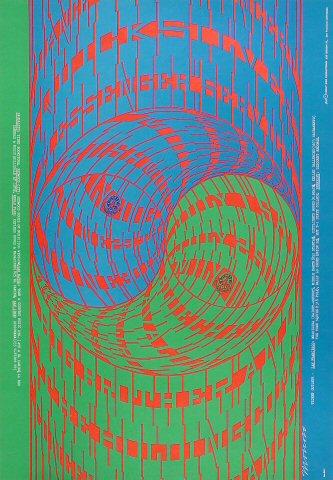Quicksilver Messenger Service Poster

Image may not exactly match item shipped.
The 1st printing of the poster is green, blue and orange/red, though it displays a significant amount of color variation throughout the print run. When held vertically with the green border along the left, there is about 1/4" of blue space below the "No.68-1" on the bottom right hand border. This printing does not have the dot described in the 2nd printing description. It measures 14" x 20 1/4" and was printed prior to the concert.
The post-concert 2nd printing is identified by a dark blue dot which is not on the originals. When held vertically with the green border to the left, the dot is located in the third pink line from the left, about 3/8" up from the bottom edge. The pink line is located between the "C" and "O" of "Concert". Most copies are trimmed all the way up to the "No.68-1", although there are a few with blue below. The green, blue and in this case pink/magenta colors remain relatively consistent throughout the print run. This printing is slightly smaller due to the border being trimmed, measuring 13 7/8" x 20".
Born in Spain, Victor Moscoso was the first of the rock poster artists with serious academic training and experience. At the Avalon Ballroom in San Francisco, Moscoso saw rock posters and decided that he could "make some money doing posters for those guys." In 1966, he began designing posters for the Avalon Ballroom; and under his own imprint, Neon Rose, a series for the Matrix, a San Francisco nightclub. Moscoso's style is most notable for its visual intensity, which was obtained by manipulating form and color to create optical effects. He used clashing, vibrating colors and deliberately illegible psychedelic lettering to demand attention.